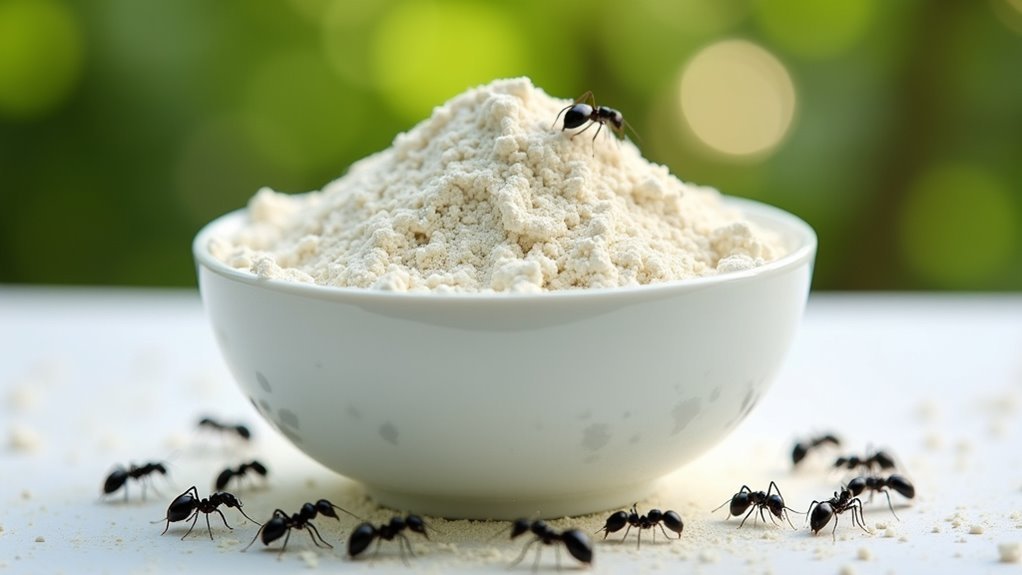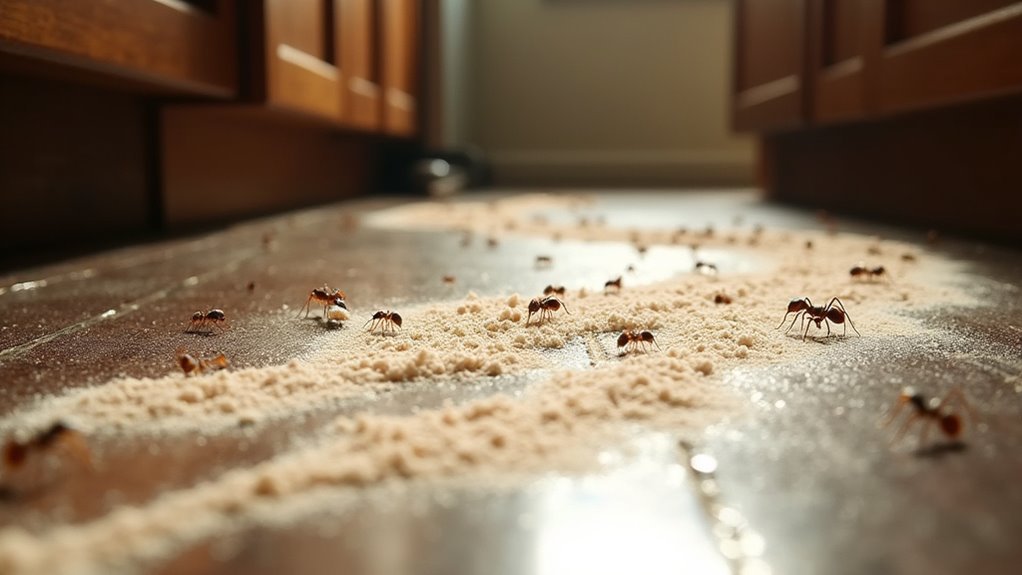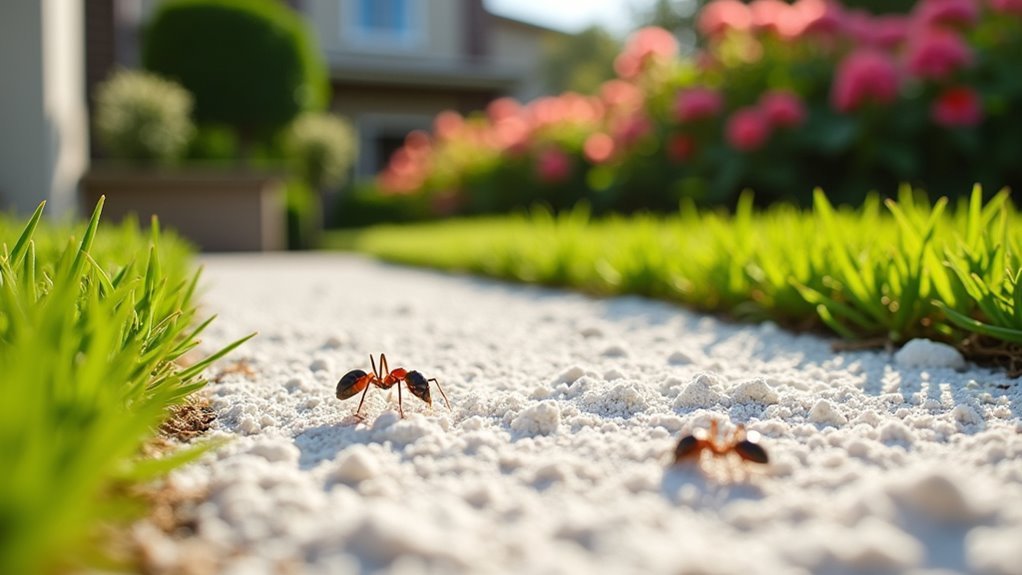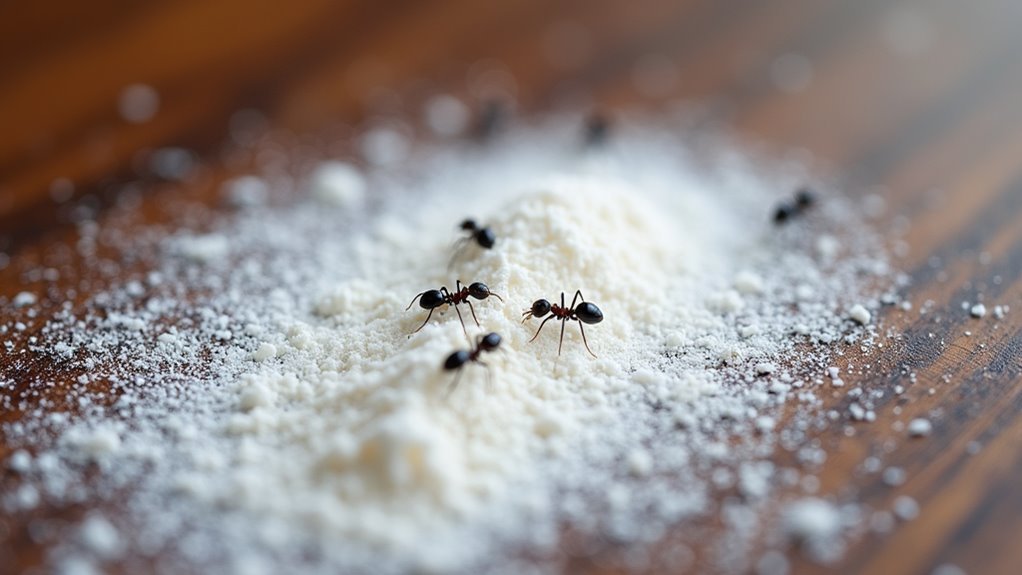You can eliminate ants fast with food-grade diatomaceous earth by applying a thin layer along ant trails and entry points using a duster or salt shaker. The microscopic silica particles damage ant exoskeletons, causing rapid dehydration within 24-48 hours of contact. Focus on baseboards, windowsills, and visible trails where ants travel most frequently. Keep the treatment undisturbed and monitor ant activity to assess effectiveness. This thorough approach will help you master complete ant elimination strategies.
What Is Diatomaceous Earth and How Does It Work Against Ants

Diatomaceous earth (DE) transforms ancient microscopic algae called diatoms into a powerful weapon against ant invasions. This fine powder contains silica with razor-sharp edges that slice through ant exoskeletons when they walk across it.
As a mechanical insecticide, DE works differently from chemical pesticides by physically damaging ants rather than poisoning them.
Unlike toxic sprays that poison insects, diatomaceous earth acts as a mechanical insecticide that physically damages ant exoskeletons without harmful chemicals.
When ants contact DE, the powder sticks to their bodies and cuts through their protective outer layer. This damage causes rapid dehydration as moisture escapes through the compromised exoskeleton.
You’ll find DE effective because it eliminates ants without toxic chemicals, making food-grade DE safe around your family and pets. This natural approach lets you control ants while maintaining a chemical-free environment in your home.
Types of Diatomaceous Earth: Food-Grade Vs Pool-Grade Safety
While diatomaceous earth offers an excellent natural solution for ant control, choosing the wrong type can put your family’s health at risk.
You’ll find two main varieties: food-grade diatomaceous earth and pool-grade DE. Food-grade is safe for human and pet use, containing 80-90% silica with no harmful additives. It’s non-toxic and environmentally friendly, making it perfect for indoor ant control around children and pets.
Pool-grade DE, however, is chemically treated for filtration systems and contains dangerous crystalline silica levels. Using pool-grade can cause respiratory issues and skin irritation.
Always select food-grade diatomaceous earth for pest control—it’s equally effective against insects while ensuring your family’s safety indoors.
Identifying Ant Trails and Entry Points for Targeted Treatment

Success in ant elimination depends on your ability to locate their movement patterns before applying diatomaceous earth. Start by identifying visible ant trails throughout your home, following these pathways back to their source to discover critical entry points.
You’ll notice ants prefer consistent routes between food sources and their colonies, creating predictable patterns.
Observe ant behavior carefully, noting high-activity areas near structural weaknesses, cracks, or food sources. Document these locations for targeted treatment planning.
Once you’ve mapped their movement, apply diatomaceous earth strategically along identified trails and entry points. Create thin barriers that disrupt their established pathways, forcing ant colonies to encounter the treatment.
This methodical approach guarantees maximum effectiveness rather than random application, leading to faster elimination results.
Indoor Application Methods for Maximum Effectiveness
Once you’ve mapped ant movement patterns, proper indoor application becomes your next essential step for eliminating these pests effectively. Apply diatomaceous earth using a duster or salt shaker to create a thin layer along ant trails, baseboards, and window sills. This indoor application method guarantees maximum contact with target pests.
| Application Area | Method |
|---|---|
| Ant trails | Direct dusting along visible pathways |
| Baseboards | Light coating against wall edges |
| Window sills | Even distribution across surfaces |
| Entry points | Concentrated barrier application |
Let the treatment remain undisturbed for 24-48 hours to maximize effectiveness. After eliminating ants, clean treated areas thoroughly to remove pheromone trails. Reapply diatomaceous earth if you notice new ant activity or after cleaning disturbs the powder.
Outdoor Perimeter Treatment and Foundation Protection

Protecting your home’s exterior requires establishing a defensive barrier that stops ants before they reach indoor spaces.
Create an effective perimeter treatment by sprinkling a light application of diatomaceous earth in a 6-12 inch band around your foundation, targeting known ant entry points. This protective layer must stay dry since moisture neutralizes DE’s effectiveness—reapply after rain or heavy dew.
Use a duster for thorough coverage in hard-to-reach areas around doorways and garden beds where ant activity occurs.
Monitor your treated perimeter regularly and adjust your strategy if ants find alternate routes. Consistent outdoor inspections and reapplications maintain ongoing ant control, preventing new infestations from establishing around your home’s foundation through this reliable barrier system.
Safety Precautions When Handling and Applying Diatomaceous Earth
You’ll need proper protective equipment before handling diatomaceous earth to prevent skin irritation and respiratory issues.
Always wear gloves and a dust mask, and guarantee you’re working in a well-ventilated area to minimize exposure to airborne particles.
Following safe application methods protects both you and your family while maximizing the effectiveness of your ant control efforts.
Proper Protective Equipment
When you gear up to handle diatomaceous earth, proper protective equipment becomes your first line of defense against potential health risks. The fine powder particles can cause skin irritation and pose inhalation risks, making safety gear vital for effective application.
Vital protective equipment includes:
- Gloves – Always wear protective gloves to prevent skin irritation and shield your hands from the abrasive fine powder during handling and application.
- Respiratory mask – Use a dust mask or respiratory mask to avoid inhaling diatomaceous earth particles, which can irritate your respiratory system.
- Protective eyewear – Wear safety glasses or goggles to protect your eyes from accidental dust exposure during application.
Additionally, guarantee proper ventilation in your work area to minimize airborne particles and reduce inhalation risks while treating ant infestations.
Safe Application Methods
After donning your protective equipment, focus on application techniques that minimize dust exposure and maximize safety. Use a duster or salt shaker to apply diatomaceous earth precisely, creating a thin layer along ant trails and entry points. This controlled method prevents excessive dust clouds that could compromise your respiratory mask’s effectiveness.
Always work in a well-ventilated area to reduce airborne particles and maintain comfortable breathing conditions.
When you wear gloves during application, you’ll protect your skin from potential irritation while maintaining better grip control. These safe application methods guarantee diatomaceous earth remains effective against ants without creating health hazards.
After treatment, thoroughly clean up any excess powder to prevent residual dust accumulation. Store remaining diatomaceous earth properly, keeping it away from children and pets for continued household safety.
Expected Timeline: How Long Before You See Results
How quickly does diatomaceous earth deliver results against ant infestations? When applied properly, diatomaceous earth becomes an effective solution that’ll kill the ants within 24 to 48 hours of initial contact with the diatomaceous powder.
You’ll notice distressed or dead ants during this timeframe as DE dehydrates them upon contact.
However, your timeline depends on several factors:
- Colony size – Larger ant populations require more time for complete elimination.
- Direct contact – DE only kills ants that physically walk through the powder.
- Ongoing monitoring – New ant routes may emerge, requiring additional applications.
For persistent infestations, you’ll need continued DE application since it doesn’t affect ants that avoid treated areas.
Monitor activity closely and reapply as needed for complete eradication.
Monitoring and Reapplication Strategies for Persistent Infestations
Since diatomaceous earth only affects ants that directly contact the powder, you’ll need to establish a systematic monitoring approach to guarantee complete elimination of persistent infestations.
Track ant activity for 24-48 hours after initial application to assess effectiveness. When ants continue appearing, observe their movement patterns to identify new entry points requiring treatment.
| Monitoring Timeline | Action Required |
|---|---|
| 0-24 hours | Observe initial ant response |
| 24-48 hours | Assess treatment effectiveness |
| 48-72 hours | Track alternate routes |
| Weekly | Reapply after moisture exposure |
Reapply diatomaceous earth in areas showing persistent activity, especially after cleaning or rain exposure. Combine DE with sealing entry points and removing food sources for enhanced results. Maintain consistent observation schedules to adjust your strategy based on ant behavior changes.
Cleanup and Post-Treatment Surface Preparation
Once you’ve successfully eliminated the ant colony, you’ll need to remove all residual DE powder from treated surfaces to prevent attracting new pests.
Thoroughly sanitize these areas with warm soapy water to eliminate pheromone trails that could invite future infestations.
This critical cleanup phase guarantees your ant control efforts provide lasting results and maintains a clean, pest-free environment.
Remove Residual DE Powder
After successfully eliminating the ant infestation, you’ll need to remove all traces of diatomaceous earth from treated surfaces to complete the process.
Proper cleanup prevents clogging your vacuum and guarantees no residual powder remains to attract future ant activity.
Follow these essential steps to clean up diatomaceous earth effectively:
- Vacuum up diatomaceous earth carefully – Use a shop vac instead of your regular vacuum to prevent damage and clogs from the fine powder particles.
- Thoroughly clean all treated surfaces – Use a damp cloth to wipe away powder residue, eliminating ant pheromones that could trigger re-infestation.
- Dispose of remaining DE responsibly – Follow product guidelines to prevent environmental impact on beneficial insects while removing any lingering food sources that attracted the original infestation.
Sanitize Treated Surface Areas
Following diatomaceous earth removal, you’ll want to sanitize the treated areas with a thorough disinfecting process that eliminates lingering ant pheromones and prevents re-infestation.
After you vacuum up all DE residue with your shop vacuum, focus on extensive cleanup of surfaces where ants traveled. Wash these areas with warm, soapy water or disinfectant to remove pheromone trails that could attract future ant colonies.
Use a damp cloth to wipe down all treated surfaces, ensuring you’ve captured any remaining diatomaceous earth particles. Pay special attention to corners, cracks, and entry points where ants commonly travel.
This sanitizing step is essential because residual pheromones can signal other ants that your home is a viable food source, undermining your pest control efforts.
Prevent Future Ant Returns
Since effective ant elimination extends beyond the initial treatment, maintaining a clean environment becomes your strongest defense against future invasions.
To prevent future returns, you’ll need to thoroughly eliminate pheromones from treated surfaces and remove remaining DE once ants are gone. This prevents accidental ingestion by pets or children while maintaining safety.
Follow these essential steps:
- Clean all treated surfaces – Wash floors and areas where ants were present to remove food sources and scent trails that attract new colonies.
- Monitor ant activity regularly – Inspect treated areas weekly for signs of new infestations, staying vigilant against potential returns.
- Dispose of leftover diatomaceous earth safely – Follow product guidelines for proper disposal to guarantee environmental responsibility and safe handling practices.
When Professional Pest Control Is Necessary Despite DIY Efforts
While diatomaceous earth proves effective for many ant problems, some infestations demand professional intervention to achieve complete elimination. If you’ve applied diatomaceous earth consistently but ants persist, you’re likely dealing with hidden nests or extensive ant infestations that require specialized treatments.
Carpenter ants present particular challenges since they cause structural damage requiring immediate professional attention. An ant colony’s reproductive capacity makes DIY ant control difficult—queens lay up to 800 eggs daily, overwhelming home remedies.
| DIY Limitations | Professional Solutions |
|---|---|
| Surface-level treatment | Deep nest elimination |
| Generic approach | Species-specific targeting |
| Limited access tools | Specialized equipment |
A pest control professional accurately identifies ant species and provides targeted treatments for effective eradication, preventing further complications from delayed intervention.
Frequently Asked Questions
How Long Does It Take for Diatomaceous Earth to Kill Ants?
You’ll see individual ants dying within 24 hours of direct contact with diatomaceous earth. However, you’ll need several days and multiple reapplications to eliminate an entire colony completely.
Why Is Diatomaceous Earth Not Killing Ants?
You’re likely not achieving direct contact with ants, they’re avoiding treated areas, moisture’s neutralizing the powder, or you’re dealing with protective ant species that don’t traverse the diatomaceous earth.
What Kills Ants the Quickest?
You’ll get fastest results with liquid ant baits containing borax or commercial ant sprays for immediate kills. Professional-grade gel baits eliminate entire colonies within days by targeting queens directly.
Why Do Exterminators Not Use Diatomaceous Earth?
Exterminators don’t use diatomaceous earth because you’ll wait days for results, it won’t eliminate hidden queens or colonies, requires labor-intensive application, and chemical treatments provide faster, more thorough pest control solutions.
In Summary
You’ve got a powerful, natural weapon against ants with diatomaceous earth. Follow proper application techniques, target entry points, and maintain consistent treatment schedules for best results. Remember to use only food-grade DE indoors and reapply after rain or cleaning. While it’s not an instant solution, you’ll see significant ant reduction within days to weeks. If infestations persist despite thorough treatment, don’t hesitate to call professional pest control services.




Leave a Reply